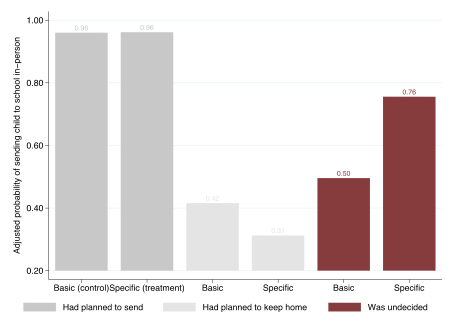Going into the third year of the pandemic, children and educators are scrambling to recover from two years of COVID-induced disruptions to learning. These disruptions have negatively affected children’s learning progress, as well as their mental and physical health. Billions of dollars of federal COVID recovery funds are flowing into school systems and are being used to fund tutoring, after school interventions, counseling and mental health services and summer school programs, among others. But without effective messaging about the value of these opportunities for children, parents might not enroll their children to participate. Now is the time to generate parent interest and uptake in new and expanded programs, in both academic and non-academic areas, intended to help children with their academic progress, and mental and physical health.
But how do we get parents, students, and families interested in program offerings? Our recent survey experiment demonstrated the power of targeted messaging to influence parent attitudes about an important educational decision they were facing at the time of our experiment in summer of 2020: whether or not to send their child to school in-person. Our findings – that messaging does indeed matter – has important implications for school and district leaders.
Over the last two school years our Understanding America Study survey of parents with K-12 children in their household helped to shed light on the huge disparities within and across children’s access to, and preferences for, in-person learning. As the pandemic unfolded, UAS data helped expose tremendous variation in in-person school attendance, demonstrating repeatedly over 2020 and 2021 that minority students were learning remotely at higher rates than white students across the country. As late as the summer of 2021, some parents were still feeling “school hesitant;” our UAS data showed (see Figure 1) that overall, 15% of a nationally representative panel of American families either planned to keep their children home or were unsure of their decision (with Black and Hispanic parents even more likely to be school hesitant; 26% and 18%, respectively).

Several factors influenced school hesitancy. One cluster of reasons related to what we called general “well-being,” for instance, that the parent reported that their child was more successful learning at home. Second were reasons related to “safety,” for instance, that the parent did not feel safe sending their child to school for various reasons.
We wondered in the summer of 2021 whether varying messaging about students’ upcoming return to school in the fall might influence parents’ likelihood of sending their students to school in person, so we designed a messaging experiment and embedded it in the next wave of the UAS. In our experiment, all respondents were asked to imagine receiving “the following” communication from their child’s school administration, and were then presented with one of four randomly selected possible messages:
- A basic control message welcoming parents and their children back to school and indicating the school would comply with CDC guidelines related to COVID safety protocols.
- The control message plus a “safety” message that added details about safety protocols, vaccination rates, and community COVID rates.
- The control message plus a “well-being” message that encouraged parents to send children back to school in person because of the negative academic and nonacademic impacts of the pandemic on children,
- The control message plus a “combined” message that added both the safety and fit messages.
We then asked parents how likely they would be to send their children back for in-person learning under the given conditions on a 1-10 scale. For parents who answered in the beginning of the survey (prior to this experiment) that they planned to send their child back to school in person or that they planned to keep their child at home, the contents of the message did not impact their reported likelihood of sending their child to school in person given the conditions in the scenario they were presented with. However, if parents were “unsure” about whether or not to send their child back to school in person at the beginning of the survey, the content of the message mattered – parents who received either the well-being, safety, or combined messages were 26 percentage points more likely to say they would send their child back for in-person learning than if they received the generic control message (Figure 2).

These results have important implications for school and district leaders. The results suggest that targeted messaging aimed at addressing parents’ most pressing concerns may have important effects on their intended actions, particularly among those who may be uncertain about future decisions, whose prior-held beliefs are not solid, or who are lacking information about a particular opportunity. Together, this implies that schools should do their best to try to understand parent concerns, and then to directly target those concerns (both in action and in messaging). Our findings contribute to the body of research demonstrating that communication and messaging matter. Though more research is needed to study the importance of messaging in supporting school and district recovery efforts, results may inform communication strategies from educational leaders at all levels. After all, these programs will only have a chance at helping the students most in need if families enroll or uptake the offer of participation.

You must be logged in to post a comment.